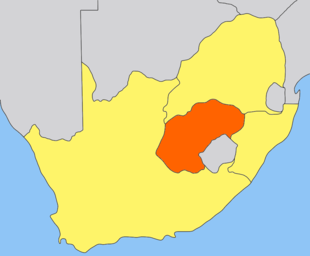Orange Free State
| Orange Vrijstaat | |||||
| Orange Free State | |||||
| 1854-1902 | |||||
|
|
|||||
| Official language | Dutch | ||||
| Capital | Bloemfontein | ||||
| Form of government | republic | ||||
| Head of state , also head of government | 1854–1855 Josias P. Hoffman 1855–1859 Jacobus N. Boshoff 1859–1863 Marthinus Wessel Pretorius 1864–1888 Johannes H. Brand 1889–1895 Francis William Reitz 1896–1902 Marthinus T. Steyn 29–31 . May 1902 Christiaan Rudolph De Wet |
||||
| surface | 129,480 km² | ||||
| independence | February 17, 1854 - May 31, 1902 | ||||
| National anthem | Folksong van den Oranje-vrijstaat | ||||
| Time zone | UTC +2 | ||||
The Oranje Free State ( Dutch : Oranje-Vrijstaat , Afrikaans : Oranje-Vrystaat ) was an independent Boer republic in southern Africa that existed in the second half of the 19th century.
The Orange Free State lost its independence as a result of the Second Boer War . The area of the then Orange Free State got its name back in 1910, but has since formed a South African province. Since 1995, the province's Free State ( english Free State ). The name of the republic goes back to the Dutch royal house of Orange .
flag
The national flag of the Orange Free State consisted of seven horizontal stripes alternating in white and orange. In addition, there was a jack in the left upper corner that represented the flag of the Netherlands . The flag of the Free State appears as part of the coat of arms of the old national flag of the Republic of South Africa , which was valid from 1928 to 1994.
history
After the British finally annexed the Cape Colony in 1814 and banned slavery in 1834 , many Boers (descendants of Dutch , French , German and other settlers) left the colony. Among other things, slavery was one of the economic foundations of Boer agriculture. Furthermore, the Boers were dissatisfied with the introduction of the British legal system and the English official language . Between 1830 and 1850, the Boers ("farmers") or Voortrekkers ("pioneers") emigrated north from the Cape Colony. This wave of emigration is also known as the Great Trek . After fighting with the Zulu ( Battle of the Blood River ), they settled north of the Cape Colony in the old border area between the Basotho and Batswana .
The Orange Free State, the area between the Oranje and Vaal rivers , was established in 1842. From 1848 to 1854 the area was administered by the British as the Orange River Sovereignty . The British recognized the state independence of the area in the Bloemfontein Convention in 1854 , after the South African Republic (also known as the Transvaal ) had obtained its independence in 1852.
In the next few years the young republic prospered, but was involved in armed conflicts with the British, Batswana, Basotho and Zulu. In the Senekal and Seqiti Wars , for example, the Basotho were pushed back to the east in order to gain further settlement areas. As the economy continued to be based on slavery and the exploitation and disenfranchisement of the black population, the state was also threatened by domestic political contradictions.
The Orange Free State was annexed by the British as the Orange River Colony as a result of the Second Boer War in 1900 and integrated into the South African Union as the Orange Free State Province in 1910 . At the head of the province was one administrator (administrator).
When the Boers took possession of the area, some Germans came to the Orange Free State, where in 1880 Joachim Graf von Pfeil lived for a time as a farmer and cattle breeder. In 1934 there were around 2,650 Germans living in the Free State.
literature
- Adalbert Brauer: The Orange Free State 1854-1888 . Heinrich & Lechte, Emsdetten 1931.
- Martin James Boon: The history of the Orange Free State . Reeves, London 1885 ( PDF file; 15.4 MB ).
- JW Bond, JF McRae, Somerset Playne: The Orange Free State, Its Pastoral, Agricultural and Industrial Resources . The Foreign and Colonial Compiling and Publishing Company, London 1912.
- George McCall Theal : History of the Emigrant Boers in South Africa. The Wanderings and Wars of the Emigrant Farmers from Their Leaving the Cape Colony to the Acknowledgment of Their Independence by Great Britain. Swan Sunshine, London 1888 ( PDF file; 26.5 MB )
- George McCall Theal : History of South Africa Swan Sunshine, London
- Volume 4. The Republics and Native Territories from 1854 to 1872. 1900. Archive version
- Volume 5. From 1873 to 1884, Twelve Eventful Years, with Continuation of the History of Galekaland, Tembuland, Pondoland, and Bethshuanaland until the Annexation of those Territories to the Cape Colony, and of Zululand until its Annexation to Natal . 1919 Volume 1 ( PDF file; 19.3 MB ), Volume 2 ( PDF file; 15.4 MB )
Web links
Individual evidence
- ↑ List of the administrator , accessed on June 3, 2014
- ↑ The clever alphabet. Volume 2. Propylaea Verlag, 1935, p. 351



